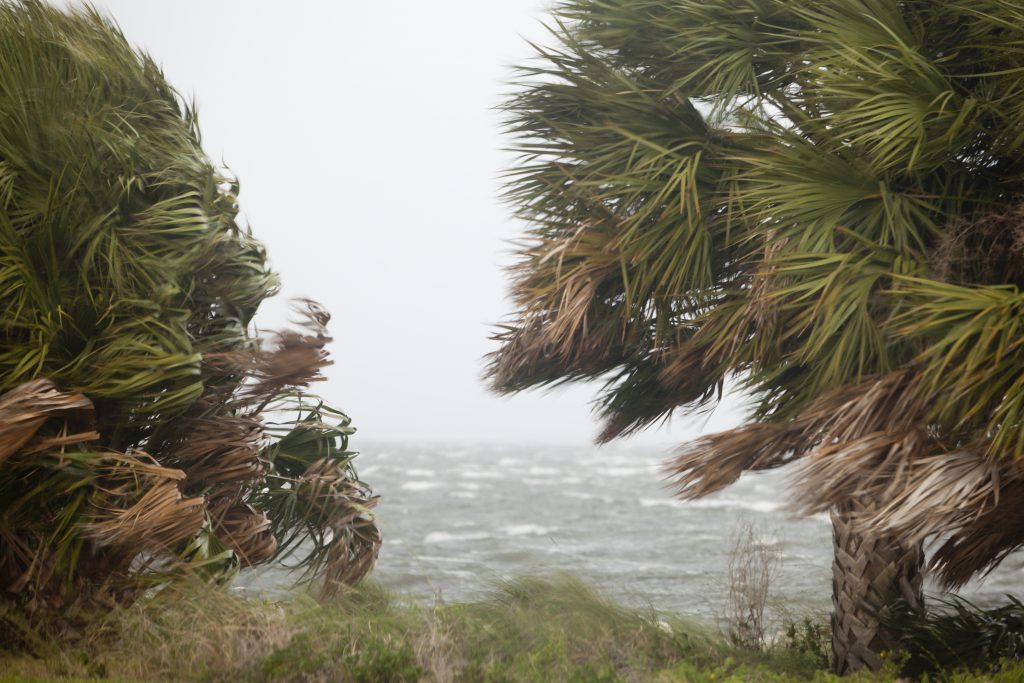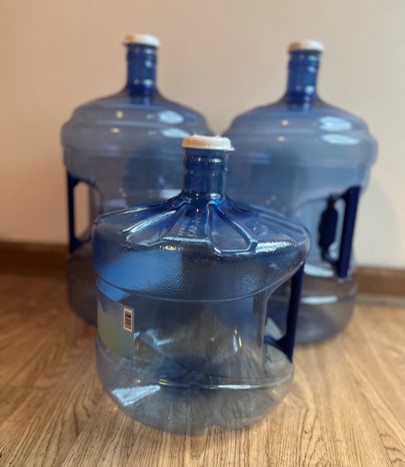
Hurricane season is just around the corner. During a natural disaster, drinking water supplies can quickly become contaminated. To be prepared, store a safe drinking water supply before a storm arrives. If you are unable to store enough water before a storm, it’s important to know how to make water safe to consume in an emergency.
Before a storm: How much water should be stored?
- Store enough clean water for everyone in the household to use 1 to 1.5 gallons per day for drinking and personal hygiene (small amounts for things like brushing teeth). Increase this amount if there are children, sick people, and/or nursing mothers in the home.
- Store a minimum 3-day supply of drinking water. If you have the space for it, consider storing up to a two-week supply.
- For example, a four-person household requiring 1.5 gallons per person per day for 3 days would need to store: 4 people × 1.5 gallons per person × 3 days = 18 gallons. Don’t forget to include additional water for pets! Store a quart to a gallon per pet per day,depending on their size.

What containers can be used to store drinking water?
Store drinking water in thoroughly washed food grade safe containers that are durable and unbreakable such as food grade plastic and enamel-lined metal containers with tight-fitting lids. These materials will not transfer harmful chemicals into the water or food they contain.
Specific examples include containers previously used to store beverages, like 2-liter soft drink bottles, juice bottles or containers made specifically to hold drinking water. Avoid plastic milk jugs if possible because they are difficult to clean. If you are going to purchase a container to store water, make sure it is labeled food-grade or food-safe.
As an extra safety measure, sanitize containers with a solution of 1 teaspoon of non-scented household bleach per quart of water (4 teaspoons per gallon of water). Use bleach that contains 5%–9% sodium hypochlorite. Add the solution to the container, close tightly and shake well. Make sure that the bleach solution touches all the internal surfaces. Let the container sit for 30 seconds and pour the solution out. You can let the container air dry before use or rinse it thoroughly with clean water.
Best practices when storing drinking water
- Store water away from direct sunlight, in a cool dark place if possible. Heat and light can slowly damage plastic containers and can eventually lead to leaks.
- Make sure caps or lids are tightly secured.
- Store smaller containers in a freezer. You can use them to help keep food cool in the refrigerator if the power goes out during a storm.
- Keep water containers away from where toxic substances (such as gasoline, kerosene, or pesticides) are stored. Vapors from these substances can penetrate plastic.
- When possible, use water from opened containers in one or two days if they can’t be refrigerated.
More information on preparing an emergency drinking water supply can be found at the Centers for Disease Control (CDC) and in the EDIS Publication Preparing and Storing an Emergency Safe Drinking Water Supply
After a storm: Ensuring a safe drinking water supply
If a boil water notice has been issued in the area you live or you suspect your water supply may be contaminated, don’t consume it. Do not use it for drinking, preparing baby formula or food, making ice (if you have electricity), washing dishes, or brushing your teeth. Don’t swallow water when bathing. If you have any open cuts or wounds, do not use it for bathing. Instead, use your own clean, stored water supply or use bottled water.
If you don’t have access to clean water, you can boil, disinfect, and filter your water during an emergency to make it safe to drink. But, if your water is contaminated by fuel or toxic chemicals, boiling or disinfection won’t make it safe to drink. In these cases, it’s important to call your local health department for guidance and use bottled water instead.
Boiling water is the most effective way to destroy pathogens in water including viruses, bacteria, and parasites such as Cryptosporiduim and Giardia. If the water is cloudy or murky, let it settle and filter it through a clean cloth or coffee filter before boiling.
- Once water begins boiling, continue to boil it for at least one minute.
- Let the water cool and transfer it to a clean, food-grade container with a tight lid.
- You can improve the taste of boiled water by aerating it (transfer water back and forth from one clean container to another) or you can add a pinch of salt for each quart of boiled water.
Disinfecting water will kill most viruses and bacteria, but it’s not as effective in killing parasites (like Giardia and Cryptosporidium) as boiling. Disinfect water by using the following amounts of household chlorine bleach (5%-9% sodium hypochlorite) and water. Do not use ‘splashless’ bleach or scented bleach. If the water is cloudy or murky, filter through a clean cloth or coffee filter before disinfecting. If water remains cloudy, double the amount of recommended chlorine bleach.
| Amount of water | Amount of chlorine bleach (5-9% sodium hypochlorite) | |
| Clear water | Cloudy water | |
| 1 quart | 2 drops | 4 drops |
| 1 gallon | 8 drops | 16 drops |
| 5 gallons | ½ teaspoon | 1 teaspoon |
After mixing in the bleach, let the water stand for 30 minutes. If the water is still cloudy after 30 minutes, repeat the chlorination procedure once.
You can also use chlorine dioxide tablets, or iodine tablets to disinfect water. Follow the manufacturer’s instructions for disinfection.
Filtering water – According to the CDC, many filtration systems can remove parasites like Giardia and Cryptosporidium if the absolute pore size is 1 micron or smaller. This does not filter out viruses or many bacteria. When choosing a filter, it’s important to carefully read the manufacturer’s instructions to understand what the system is effective against. The CDC recommends adding a disinfectant to the filtered water (chlorine, iodine, or chlorine dioxide tablets) to kill most viruses and bacteria. Follow the manufacturer’s instructions for disinfection.
More detailed information about making water safe to drink can be found at the CDC, FEMA and the US Environmental Protection Agency (EPA).
- What to Do if a Sinkhole Opens on Your Property? - June 6, 2025
- Workshop on Private Well and Septic System Basics - October 18, 2024
- Septic system maintenance after a flood - June 7, 2024
